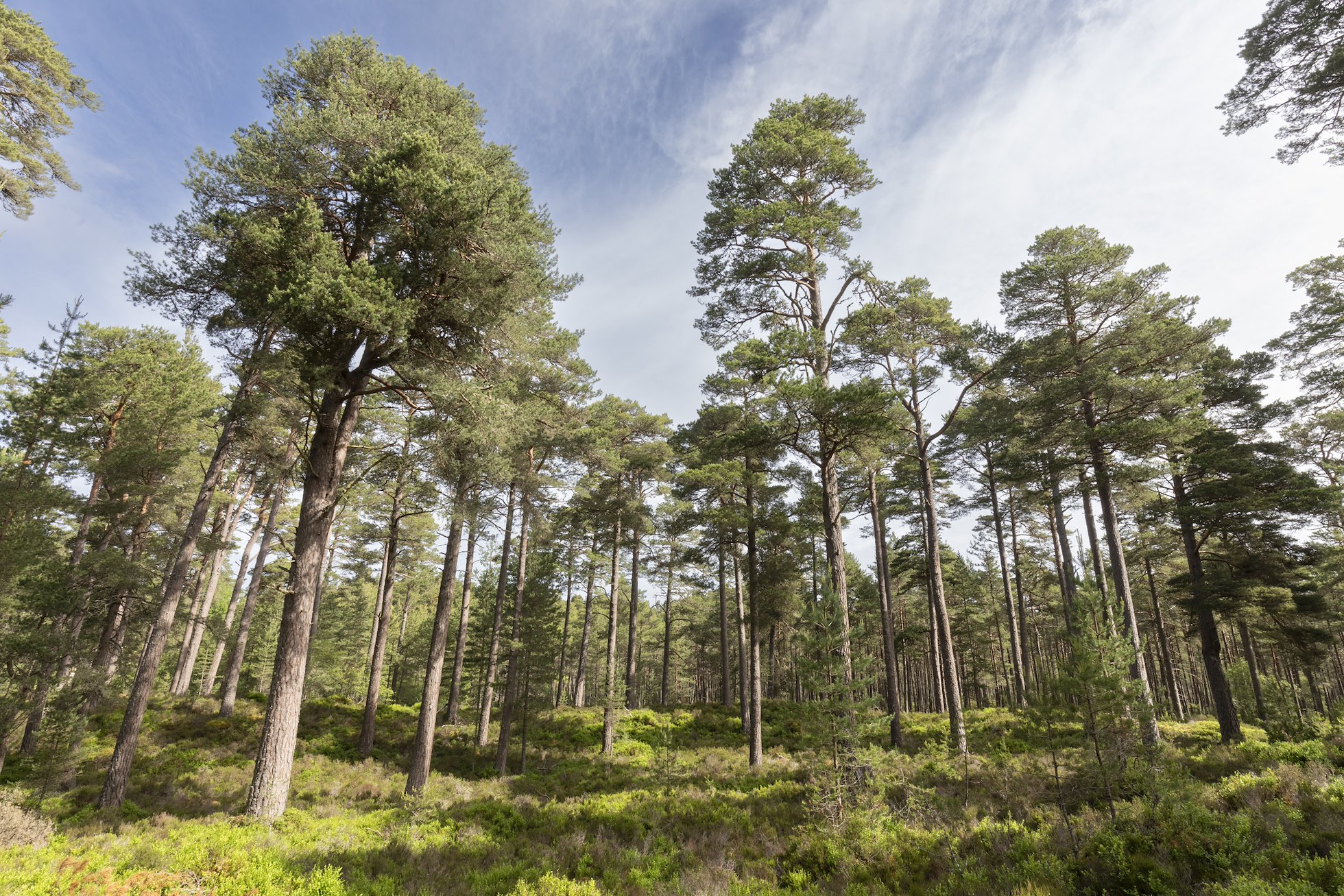Partner Portrait Anagach Woods, Highland

Scots pine (Pinus stylvestris) woodland with heather and blaeberry understorey, Anagach Woods (a Northwoods Rewilding Network land partner) Cairngorms National Park, Scotland, July 2024
Bordering the River Spey and traversed by woodland trails, Anagach Woods have a long association with the town of Grantown-on-Spey in the Cairngorms National Park. Managed by the community since 2002, this stunning Scots Pine woodland provides a special recreational amenity and wildlife experience for locals and visitors.
Originally planted in the 18th Century, the woodland has had continuous forest cover for more than 250 years and there are many Scots Pine trees over 100 years old. Felling of small areas was last carried out in the 1990s and subsequent restocking has been exclusively by natural regeneration. The woods are interspersed with dry heath, bog-cotton covered peatbogs, lochans and ancient eskers – all of which contribute to the site’s magical character.
In 1766, Sir James Grant initiated a plantation of 'fir, oak and birch' next to the River Spey. The Scots pine (fir) was grown from seed collected from the Abernethy Caledonian pinewoods, and there are many fine examples of ancient ‘granny’ pines throughout the woods.
The woods provided a valuable source of timber up until the mid-‘70s, but today retain much of their original character, dominated by pine with a good mix of birch, rowan, hazel and aspen.
Covering 386 hectares, the woods are extensive and represent one of the largest contiguous forests within the National Park, three times the area of Grantown-on-Spey itself.
(Photo credit: Steve Blow)
The woods were put up for sale in 2001. A strong connection with the town led to their purchase by Anagach Woods Trust on behalf of the community in May 2002.
The Trust’s vision for Anagach Woods is a wild pinewood that allows nature and the local community to thrive together – providing a home for many native species as well as a community space for leisure and wellbeing.
The woods are home to many endangered wildlife species, including capercaillie, the largest member of the grouse family, that needs undisturbed areas of the forest to feed and breed. In 2006, Anagach Woods was registered as a Special Protection Area for capercaillie.
Red squirrels, pine marten and crested tit can also be found here, alongside woodland regulars such as chaffinch, blue, coal and great tit, treecreeper and great spotted woodpecker.
As is typical in an ancient forest, plant life is rich. The woods boast a healthy understorey of blaeberry and heather – important for capercaillie – as well as pine woodland specialists such as intermediate wintergreen (pictured), creeping ladies tresses and twinflower.
The beautiful twinflower with its two pink bell-like flowers has strong links with Scotland’s ancient pinewoods. Standing just a few centimetres tall, it occurs in small numbers in Anagach Woods. To boost the population, Plantlife has translocated over 100 plants to six new sites within the forest.
In a similar vein, the Trust has been supporting the Royal Zoological Society of Scotland’s (RZSS) pine hoverfly project. Every year, the RZSS releases thousands of pine hoverfly larvae into specially prepared stumps, which mimic conditions found in the wild. The project is proving a great success, and there is evidence of them breeding in the woods.
(Photo credit: RZSS)
Habitat restoration forms a large part of the Trust’s practical work within the woods, largely delivered by an enthusiastic bunch of volunteers. Work parties are scheduled throughout the year, attracting folks from both the local and wider community, keen to get their hands dirty.
Activities include building leaky dams to raise the water table and create more wetland, removing non-native species, expanding existing ponds, and creating pine hoverfly stumps.
Last December, the Trust organised a ‘Cut your own’ Christmas tree event, which attracted families from the local communities and raised £1600. The trees were taken from a patch of dense regenerated Scots pines, thereby giving the remaining trees more room to grow and improving the habitat for invertebrates.
(Photo credit: Alice Fogg)
There are roe deer and brown hares within the woods, which impact naturally seeded trees through repeated browsing.
However, birch and rowan seed in huge numbers and some trees do escape the reach of hungry herbivores. Supplementary tree planting has been considered, especially for absent or under-represented species like aspen. For now though, the approach is to let nature lead through natural processes.
Diversity within the woodland extends beyond the individual species themselves. A healthy woodland comprises trees of various ages, from saplings to veterans, and includes both standing and fallen deadwood. This deadwood provides a vital habitat for many invertebrates.
Wet woodland dotted with cotton grass hosts amorous amphibians in spring, and in summer, iridescent dragonflies and damselflies dart erratically as they snaffle up airborne insects.
On the nutrient-poor bog that borders the main wood, myriad small pools pepper the landscape. They are surrounded by colourful peat-forming sphagnum moss and carnivorous sundew, whose sticky tendrils imprison some of the countless insects found here.
There are few open areas within the woodland, but along its southern edge a strip of grassland provides a refuge for butterflies, spiders and other insects. These areas are sensitively managed to mimic natural grazing and encourage a greater variety of wildflowers.
Full of life, Anagach Woods is a shining example of what a community woodland should be. A refuge for wildlife, a sanctuary for quiet reflection and somewhere for local children to have boisterous, uninhibited fun!










